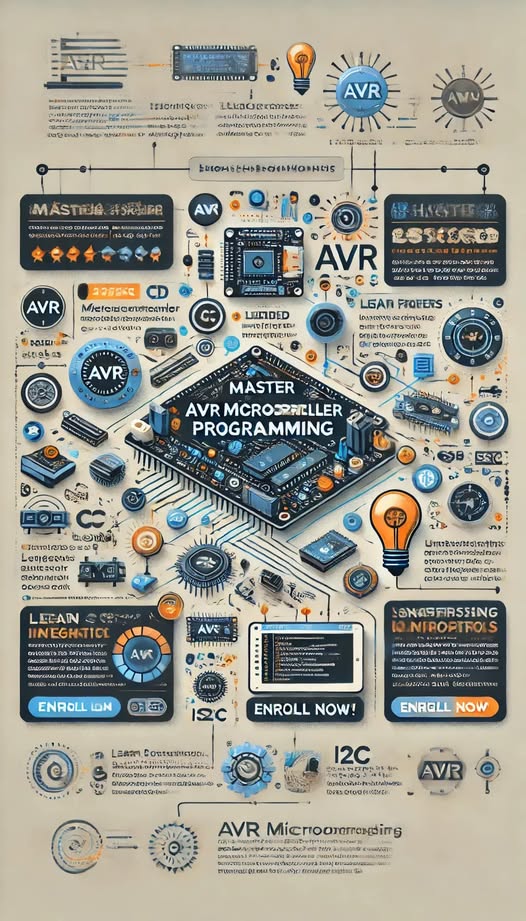
About Course
AVR Microcontroller Programming Course Plan
Code: 11007-PEM
✨ Introduction:
This course is designed to equip you with the essential and advanced skills needed to program and build embedded systems using AVR microcontrollers. Whether you are a beginner stepping into microcontrollers or someone seeking to strengthen low-level programming skills, this course offers a structured and project-driven learning path.
📜 Description:
“AVR Microcontroller Programming” is a hands-on, project-based course that takes learners from the basics of microcontroller architecture to building fully functional embedded systems.
The course focuses on low-level control, enabling students to interact directly with hardware components, use assembly and C languages, and understand how devices communicate via protocols like SPI and I2C.
By the end of the course, learners will be capable of designing, coding, and deploying real-world embedded solutions.
🎯 Course Objectives:
-
Understand the architecture and structure of AVR microcontrollers.
-
Learn programming AVR using C and Assembly languages.
-
Work with digital and analog input/output interfaces.
-
Utilize timers, interrupts, and communication protocols (USART, I2C, SPI).
-
Implement practical embedded system projects.
⏳ Course Duration:
-
8 Weeks (2 sessions per week)
🔰 Prerequisites:
-
Basic knowledge of electronics (circuits and fundamental components).
-
Basic programming knowledge (preferably C language).
-
Possession of an AVR development board such as ATmega328 or ATmega32.
🛠️ Tools and Software:
-
AVR Studio or Microchip Studio (Development Environment).
-
AVR GCC Compiler (for C programming).
-
AVR Programmer like USBasp or AVRISP mkII.
-
Hardware Kit: AVR board, LEDs, LCD displays, sensors, motors.
📚 Detailed Syllabus:
Week 1: Introduction to AVR Microcontrollers
-
Lecture 1: Introduction to AVR
-
What is AVR? Why is it used in embedded systems?
-
Comparison between AVR, PIC, and ARM.
-
AVR structure: CPU, memory, I/O ports.
-
-
Lecture 2: Development and Programming Tools
-
Setting up the development environment (Microchip Studio).
-
Understanding programmers (USBasp, AVRISP).
-
Writing the first “Hello World” program (LED on/off).
-
Week 2: Basic Programming with C and Assembly
-
Lecture 3: Basics of C Programming for AVR
-
Introduction to C for embedded systems.
-
Using the AVR GCC Compiler.
-
Basic I/O function handling.
-
-
Lecture 4: Assembly Programming in AVR
-
Introduction to Assembly language for AVR microcontrollers.
-
Writing simple Assembly programs.
-
Comparison between C and Assembly programming.
-
Week 3: Digital Input/Output Handling
-
Lecture 5: Digital I/O Basics
-
AVR I/O ports overview.
-
Configuring ports as input or output.
-
Controlling LEDs using AVR.
-
-
Lecture 6: Using Buttons and Switches
-
Reading button states (Pull-up & Pull-down Resistors).
-
Mini-project: Control LED using buttons.
-
Button debouncing techniques.
-
Week 4: Analog Input (ADC)
-
Lecture 7: Analog to Digital Conversion (ADC)
-
What is ADC and how does it work?
-
Setting up and using ADC in AVR.
-
Reading analog sensor values (e.g., temperature sensors).
-
-
Lecture 8: Processing Analog Data
-
Converting analog signals to digital.
-
Displaying data on an LCD screen.
-
Practical project: Read and display temperature sensor data.
-
Week 5: Timers and Interrupts
-
Lecture 9: Timers
-
Types of timers (Timer0, Timer1, Timer2).
-
Modes of operation (Normal, CTC, PWM).
-
Practical project: Control LED brightness using PWM.
-
-
Lecture 10: Interrupts
-
What are interrupts and how do they work?
-
Setting up external and internal interrupts.
-
Practical project: LED control using button interrupt.
-
Week 6: Communication Interfaces (USART, SPI, I2C)
-
Lecture 11: Serial Communication (USART)
-
Setting up UART communication.
-
Sending and receiving data via PC.
-
Practical project: Communication between AVR and PC using UART.
-
-
Lecture 12: Advanced Communication (SPI & I2C)
-
Setting up SPI and I2C interfaces.
-
Communicating with external devices (e.g., sensors, LCDs).
-
Practical project: Read sensor data using I2C.
-
Week 7: Persistent Storage and Ready-made Libraries
-
Lecture 13: EEPROM Memory
-
What is EEPROM and its uses?
-
Reading and writing data to EEPROM.
-
Practical project: Store and retrieve user settings.
-
-
Lecture 14: Using AVR Libraries
-
Utilizing ready-made libraries for easier programming.
-
Examples of LCD, UART, I2C libraries.
-
Customizing libraries as needed.
-
Week 8: Advanced Projects and Course Review
-
Lecture 15: Advanced Projects
-
Servo motor control project using PWM.
-
Security system project using Keypad and LCD.
-
Digital clock project using RTC Module.
-
-
Lecture 16: Review and Assessment
-
Comprehensive review of all concepts.
-
Discussion of problems and their solutions.
-
Final evaluation of the course and projects.
-
📘 Materials and Resources:
-
Theoretical explanations and references.
-
Practical examples and application projects.
-
Ready-to-use and editable code samples.
🏆 Course Outcomes:
-
Deep understanding of AVR microcontroller architecture.
-
Ability to program AVR in both C and Assembly languages.
-
Capability to implement complete practical projects.
-
Advanced skills in device communication and external control.
⏳ Time Frame:
-
Duration: 8 weeks
-
Sessions: 2 sessions per week (theoretical and practical)
-
Total Hours: ~32 sessions (approximately 48–60 hours)
Course Content
🎯AVR Microcontroller Programming
Student Ratings & Reviews



